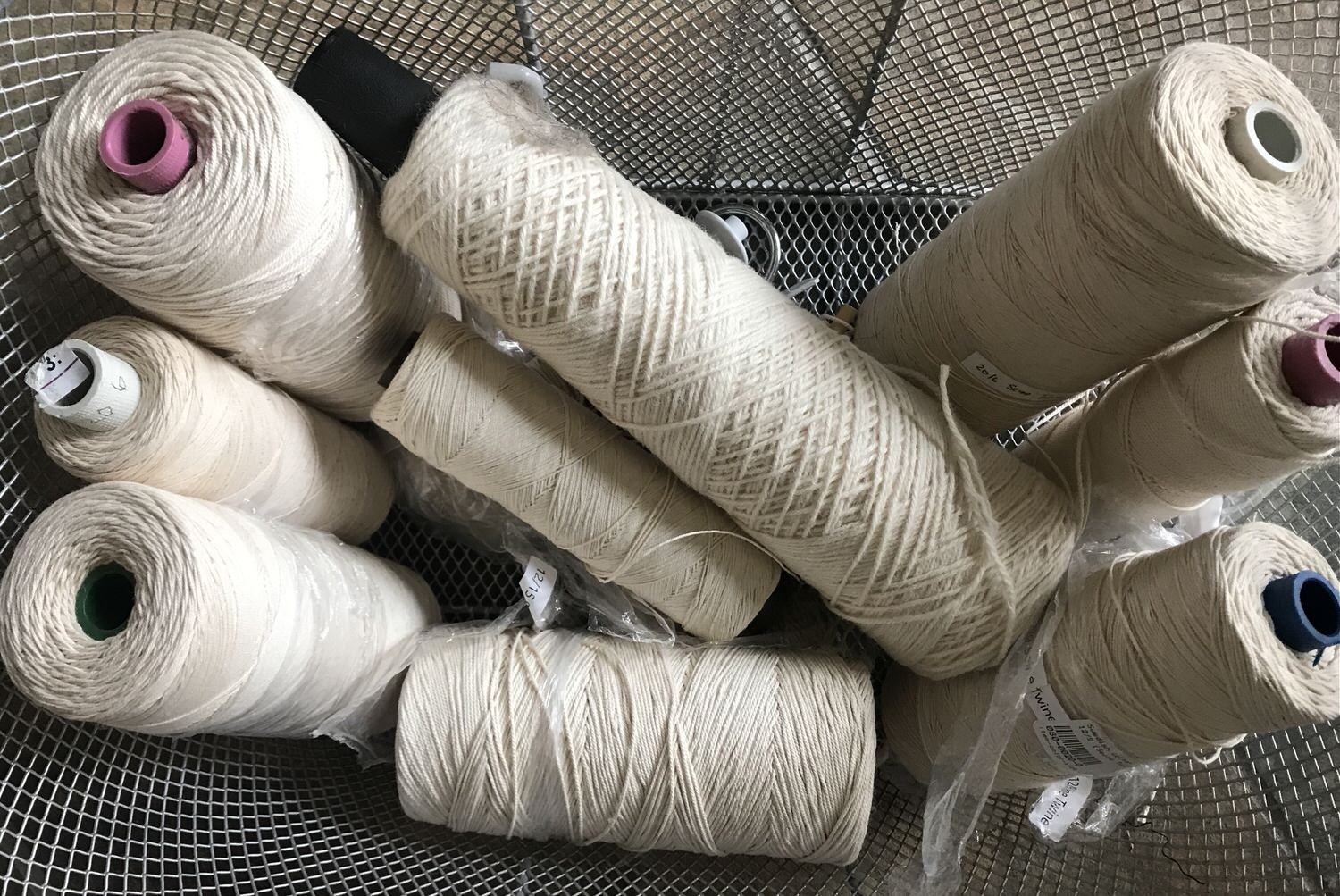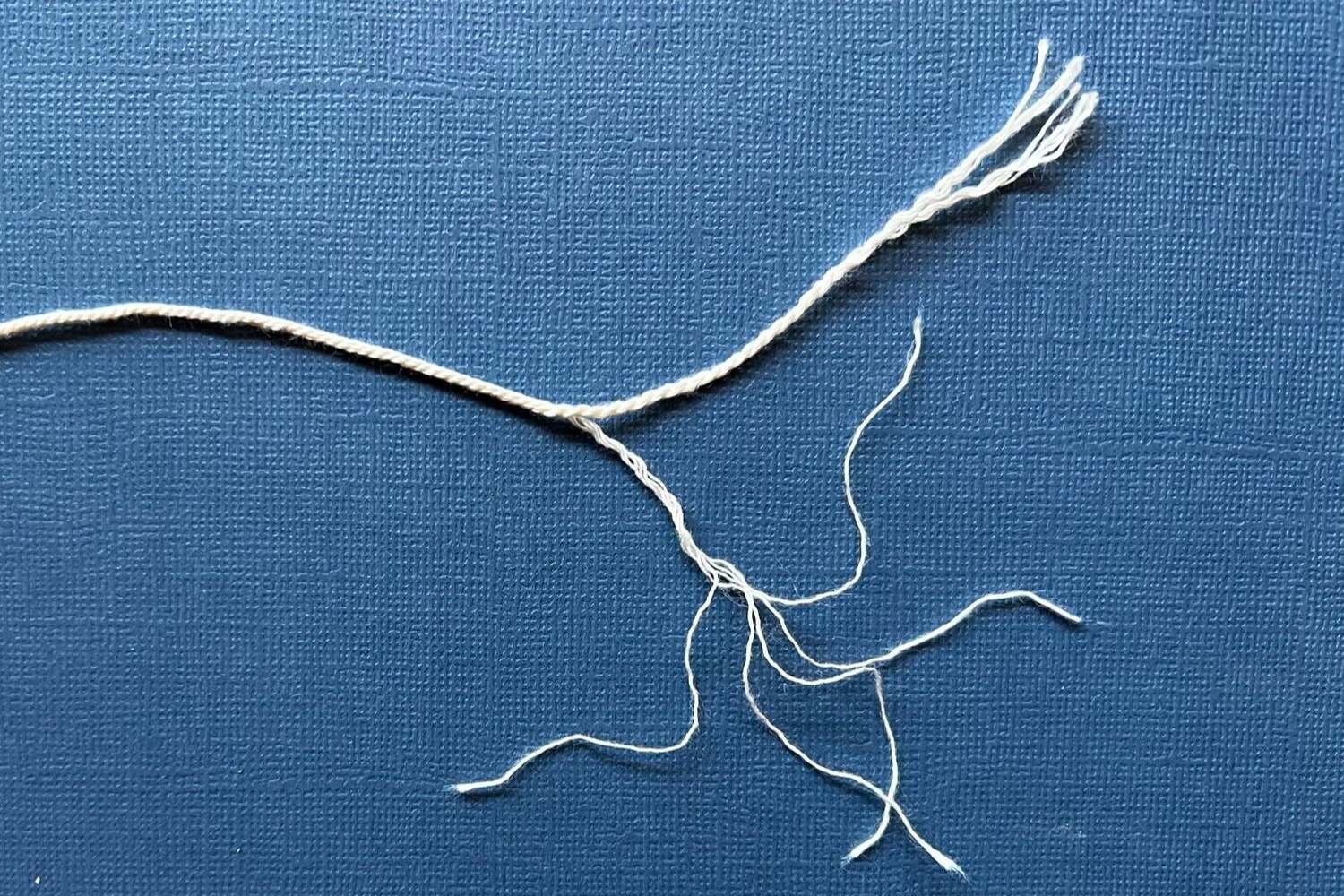Choosing yarns for Tapestry: Warp
Various sizes of Cotton Seine Twine with one cone of wool (top middle)
How do you choose yarns for tapestry?
I’ve been asked to talk about just that in the ATA Media Tour 2022 next week because of my background in knit design. Tapestry yarns are very different, though. Most of time we want something nearly opposite of what we look for in a knit yarn (softness, light, drape, maybe washability).
It can be confusing. We not only need to make a good choice of weft yarn but also warp.
Warp
The warp on the loom is the canvas. It provides the support for weft to form the surface.
For weaving tapestries, you want a strong yarn for this foundation. Some tapestry weavers use wool or linen, but the majority tend to use cotton warps, specifically a variety called Cotton Seine Twine because of its strength and ability to hold up under strong tension.
Cotton
Common Cotton Seine Twine sizes are 12/6, 12/9, 12/12, and 12/15. So what do those numbers mean and how do you choose? Here’s the easy part.
What do those numbers mean?
The first refers to a set system depending on the fiber and based on weight. In this case, that first number is the same in each size (12). The second number refers to how many strands make up the yarn. Because of this, it makes it much easier to understand that the lowest number, 12/6, would be finer than 12/15 because it has more than twice as many strands.
Comparison of sizes: Cotton Seine Twine 12/15 top; 12/6 bottom.
Notice anything about those numbers of strands? They’re all divisible by 3: 3-6-9-12-15. If you look at each of these warp sizes closely, you will see that they are actually smaller numbers of strands plied together. 12/6 is made up of 3 sets of 2 strands plied together which are then plied together to create one very strong yarn. 12/9 is made up of 3 sets of 3 strands plied together - 12/12 of 3 sets of 4 strands.… you get the idea. This plying creates a very strong warp - which I’ll repeat - is very important in tapestry.
12/15 Cotton Seine Twine unwound to show 3 plied strands of 5 plied
So what about a cotton warp other than those above? One that starts with another number rather than 12? That’s where it gets a little tricky.
While the second number refers to the number of strands, the first number refers to a standard unit of weight based on the length of the fiber per weight. Because different fibers have different weights this will vary from fiber to fiber; it’s 840 yards per pound for cotton.
For 20/6 cotton seine twine, for example, this means the stands of cotton yarns are thinner in the 20/6 than in the 12/6.
Same goes for 8/4. The 8 would indicate a thicker yarn made up of 4 strands.
However, 8/4 cotton warp is not the best choice for tapestry weaving. Rebecca Mezoff, in her “The Art of Tapestry Weaving” book points this out, saying that this is because the 4 strands are only plied together one time. They are single strands, making them weaker.
With all those different size options, how do you choose?
Answer is, it depends. It depends on a lot of factors. Most specifically, the sett, or how many ends per inch you warp your loom.
And this depends on how you want the woven tapestry to appear. It’s a personal choice. If you want the surface to be smoother, not showing the rib of the warp, then you might weave with 12/6 or 12/9 at 8EPI. But if you want that rib, or “bead” as it’s referred to, then choose 12/12 or even 12/15 at 8 EPI. It all takes experimentation and there are no straight answers. Whether you want the surface to be smooth or show the rib of the warp, is also going to be dependent on the weft you choose as well.
So that’s cotton; what about wool? Or linen?
These guidelines are from the Britannica encyclopedia:
“In the United States, the system is based on the number of hanks per pound, with a hank of 840 yards for cotton and spun silk, 300 yards (a lea) for linen, 256 yards for woolen yarns, and 560 yards for worsted yarns….”
Notice that 256 for woolen yarns but 560 for worsted?
There you go, more complexity.
Wool
Woolen versus Worsted
What does that mean?
It’s a way of describing the method that was used to construct the yarn.
A worsted yarn is preferred when looking for a good weft yarn in tapestry.
In natural fibers, short staple fibers are often separated from the long staples and spun into different types of yarn. Short staple wools are carded and spun into soft yarns of low-twist (woolen spun). Long staple wools are combed along with carding (worsted), and when spun become more compact, stronger, and more tightly twisted. These stronger - so worsted - fibers are what we look for in tapestry yarns.
If you want to use wool warp, look for the same qualities that make the seine twine a good match: a strong worsted fiber, preferably plied. I personally have not used wool as a warp for tapestry, but I did find a wonderful article from Weavers Bazaar that has piqued my interest!
Linen
If choosing linen for warp, you want Line Linen. Line Linen is stronger than Tow Linen and is spun from long filaments which add to the strength. Just keep in mind that linen is not as forgiving as cotton or wool warps and can be more difficult to work with, particularly in the tensioning.
One more complication: Not all countries place the number of strands as the second number. Some reverse it, for example EPiC is described as 2/18 but that’s the same as Mora at 18/2. The lower number will refer to the number of lengths of yarn.
That’s all I’ve got to say about warp for tapestry. I’ve written much more about Cotton Seine Twine than other fibers, but that’s what I’ve worked more extensively with and what I see more commonly being used these days. It’s a good place to start.
Next week I’ll write about the Wonderful World of Weft yarns!
I’ll also be talking about both warp and weft on Thursday with the ATA Media Tour 2022. Join me on IG Live at 2pm EST @tapestryjourneys, January 20th.
The ATA Media Tour 2022 is centered around the life of a tapestry beginning with Inspiration on Monday, January 17th with Mary Zicafoose, Design on Tuesday with Tommye Scanlin, followed by Dyeing on Wednesday with David Heustess, then Yarn and myself on Thursday and ending with Susan Iverson on Finishing for Friday. Join us. Follow the hashtag for reminders #atamediatour or #atamediatour2022 . All presentations will begin at 2pm EST from the individual profiles. Come with questions!


